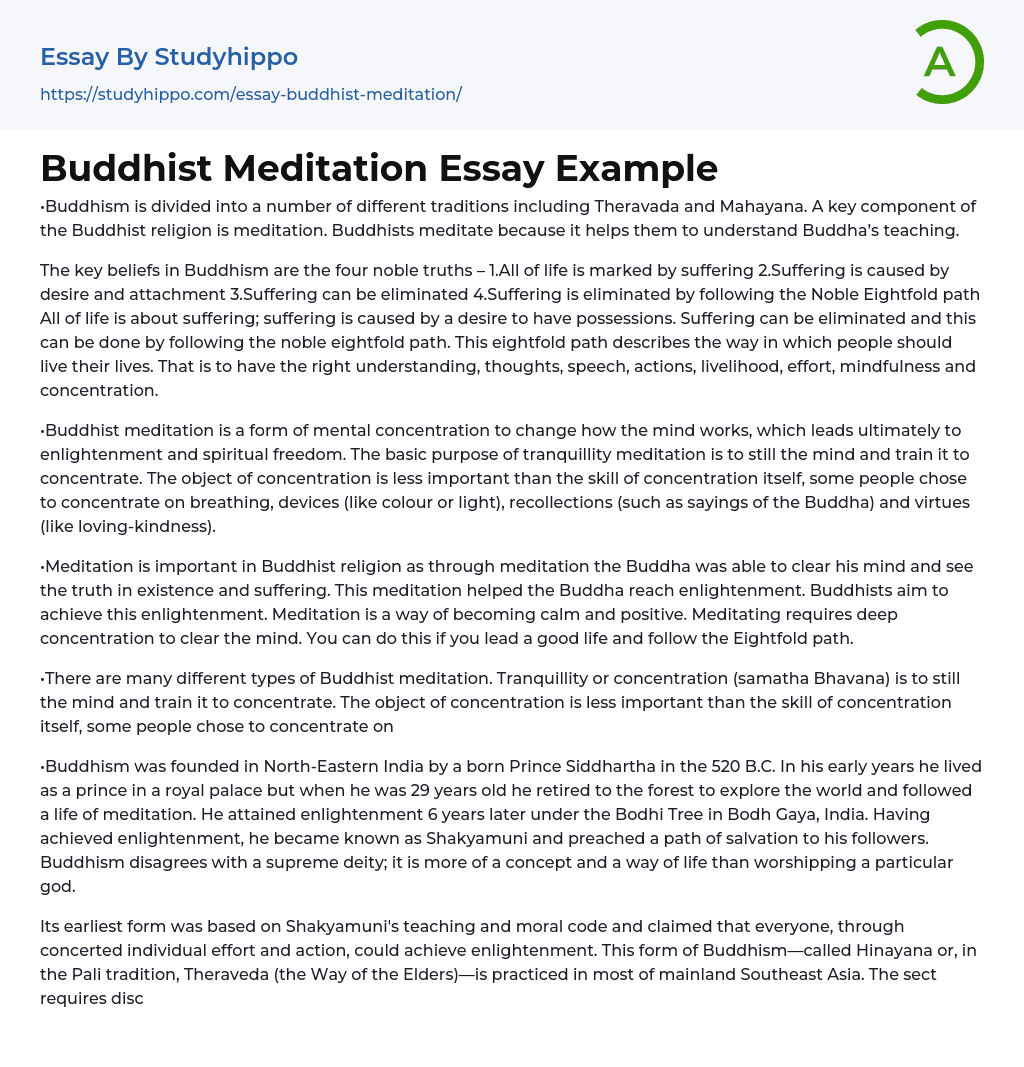•Buddhism is divided into a number of different traditions including Theravada and Mahayana. A key component of the Buddhist religion is meditation. Buddhists meditate because it helps them to understand Buddha’s teaching.
The key beliefs in Buddhism are the four noble truths – 1.All of life is marked by suffering 2.Suffering is caused by desire and attachment 3.Suffering can be eliminated 4.Suffering is eliminated by following the Noble Eightfold path All of life is about suffering; suffering is caused by a desire to have possessions. Suffering can be eliminated and this can be done by following the noble eightfold path. This eightfold path describes the way in which people should live their lives. That is to have the right understanding, thoughts, speech, actions, livelihood, effort, mindfulness and concentration.
•B
...uddhist meditation is a form of mental concentration to change how the mind works, which leads ultimately to enlightenment and spiritual freedom. The basic purpose of tranquillity meditation is to still the mind and train it to concentrate. The object of concentration is less important than the skill of concentration itself, some people chose to concentrate on breathing, devices (like colour or light), recollections (such as sayings of the Buddha) and virtues (like loving-kindness).
•Meditation is important in Buddhist religion as through meditation the Buddha was able to clear his mind and see the truth in existence and suffering. This meditation helped the Buddha reach enlightenment. Buddhists aim to achieve this enlightenment. Meditation is a way of becoming calm and positive. Meditating requires deep concentration to clear the mind. You can do this if you lead a good life and follow the
Eightfold path.
•There are many different types of Buddhist meditation. Tranquillity or concentration (samatha Bhavana) is to still the mind and train it to concentrate. The object of concentration is less important than the skill of concentration itself, some people chose to concentrate on
•Buddhism was founded in North-Eastern India by a born Prince Siddhartha in the 520 B.C. In his early years he lived as a prince in a royal palace but when he was 29 years old he retired to the forest to explore the world and followed a life of meditation. He attained enlightenment 6 years later under the Bodhi Tree in Bodh Gaya, India. Having achieved enlightenment, he became known as Shakyamuni and preached a path of salvation to his followers. Buddhism disagrees with a supreme deity; it is more of a concept and a way of life than worshipping a particular god.
Its earliest form was based on Shakyamuni's teaching and moral code and claimed that everyone, through concerted individual effort and action, could achieve enlightenment. This form of Buddhism—called Hinayana or, in the Pali tradition, Theraveda (the Way of the Elders)—is practiced in most of mainland Southeast Asia. The sect requires disciples to become monks and it becomes a major part of their daily activities to meditate to eventually reach nirvana or enlightenment, the ultimate state of bliss that excels suffering.
•There are three main types of Buddhism in the world. Theravada means the teaching of the elders and is the oldest of Buddhist teachings. It is a more conservative way of teaching Buddhism which is closer to early Buddhism than other Buddhist traditions. Mahayana
originated in India in the 1st century B.C. and is the largest major tradition of Buddhism today. Theravada Buddhists strive to become arhats - people who have attained enlightenment and nirvana. They also believe existing arhats should teach Buddhism and be involved in the community. Vajrayana this form of Buddhism emerged in India in the 6th and 7th centuries A.D. when Hinduism was going through a major revival in India. In response to this some Buddhists were influenced by aspects of Hinduism, this made it a more complex, philosophical and ritual system.
•The main location where Buddhism is practiced is China, Japan, Korea and Southeast Asia. The people in these countries practice meditation. People who dedicate their lives to the Buddha’s teachings rae called monks and nuns. Men become monks. Monks usually get up at five o’clock in the morning. They study the Buddha’s teaching after breakfast. Sometimes they teach Dharma to people in the afternoon. In the evening they meditate. They keep their minds clean and have kind hearts. Women become nuns. They also shave their heads. They usually wear robes in brown, yellow or grey. They also study the Dharma and meditate. They live simple lives and work hard for the happiness of people. They are wise and cheerful, just like the monks.
- Academia essays
- Higher Education essays
- Language Learning essays
- Studying Business essays
- Education System essays
- Study essays
- First Day of School essays
- Scholarship essays
- Pedagogy essays
- Curriculum essays
- Coursework essays
- Studying Abroad essays
- Philosophy of Education essays
- Purpose of Education essays
- Brainstorming essays
- Educational Goals essays
- Importance Of College Education essays
- Brown V Board of Education essays
- The Importance Of Higher Education essays
- Online Education Vs Traditional Education essays
- Academic And Career Goals essays
- Academic Integrity essays
- Brown Vs Board Of Education essays
- Distance learning essays
- Technology in Education essays
- Vocabulary essays
- Writing Experience essays
- Importance of Education essays
- Early Childhood Education essays
- Academic Degree essays
- Academic Dishonesty essays
- School Uniform essays
- Academic writing essays
- Cheating essays
- Bachelor's Degree essays
- MBA essays
- College Life essays
- Grade essays
- Diploma essays
- Phonology essays
- Sentence essays
- Filipino Language essays
- Pragmatics essays
- Millennium Development Goals essays
- History Of Education essays
- Graduate School essays
- Middle School essays
- School essays
- Special Education essays
- University essays




